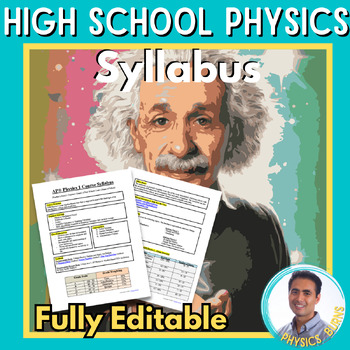Physics Burns
1.1k Followers
Grade Levels
9th - 12th, Higher Education, Adult Education, Homeschool
Subjects
Resource Type
Standards
NGSSHS-PS2-2
NGSSHS-PS3-1
NGSSHS-PS2-1
NGSSHS-PS4-1
NGSSHS-PS2-4
Formats Included
- Word Document File
Pages
3 pages
Physics Burns
1.1k Followers
Also included in
- Full High School Physics Curriculum. Every lesson is editable, so you can tweak things to fit your classroom perfectly. Power Points, Homework, Reviews, Quizzes, Tests, and Guided Notes are all included.These are the exact lessons and assignments I give to my students in my regular and honors classePrice $239.99Original Price $354.90Save $114.91
- Perfect bundle for the first week of your physics class. This bundle includes differentiated syllabuses, icebreakers, math reviews, a student survey, pacing guides, lab safety guidelines, and a formula sheet. Additionally, we've added a day-by-day guide for the first week of school, so you know exacPrice $12.99Original Price $15.34Save $2.35
Description
High School Physics editable syllabus template. A perfect template to give your students on the first week of school. Or if you need to submit it for administration. It goes over everything that you need.
Topics Covered:
1) Course Overview
2) Required Materials
3) Class Expectations & Consequences
4) Textbook Recommendations
5) Grade Scale & Weighting
6) Policy on Tests
7) Policy on Quizzes
8) Policy on Homework
9) Policy on Labs
10) Policy on Office Hours
11) Course Outline
Check out my Youtube Channel, Facebook Group, and Follow my Store :)
Total Pages
3 pages
Answer Key
Included with rubric
Teaching Duration
45 minutes
Report this resource to TPT
Reported resources will be reviewed by our team. Report this resource to let us know if this resource violates TPT’s content guidelines.
Standards
to see state-specific standards (only available in the US).
NGSSHS-PS2-2
Use mathematical representations to support the claim that the total momentum of a system of objects is conserved when there is no net force on the system. Emphasis is on the quantitative conservation of momentum in interactions and the qualitative meaning of this principle. Assessment is limited to systems of two macroscopic bodies moving in one dimension.
NGSSHS-PS3-1
Create a computational model to calculate the change in the energy of one component in a system when the change in energy of the other component(s) and energy flows in and out of the system are known. Emphasis is on explaining the meaning of mathematical expressions used in the model. Assessment is limited to basic algebraic expressions or computations; to systems of two or three components; and to thermal energy, kinetic energy, and/or the energies in gravitational, magnetic, or electric fields.
NGSSHS-PS2-1
Analyze data to support the claim that Newton’s second law of motion describes the mathematical relationship among the net force on a macroscopic object, its mass, and its acceleration. Assessment is limited to one-dimensional motion and to macroscopic objects moving at non-relativistic speeds. Examples of data could include tables or graphs of position or velocity as a function of time for objects subject to a net unbalanced force, such as a falling object, an object sliding down a ramp, or a moving object being pulled by a constant force.
NGSSHS-PS4-1
Use mathematical representations to support a claim regarding relationships among the frequency, wavelength, and speed of waves traveling in various media. Examples of data could include electromagnetic radiation traveling in a vacuum and glass, sound waves traveling through air and water, and seismic waves traveling through the earth. Assessment is limited to algebraic relationships and describing those relationships qualitatively.
NGSSHS-PS2-4
Use mathematical representations of Newton’s Law of Gravitation and Coulomb’s Law to describe and predict the gravitational and electrostatic forces between objects. Emphasis is on both quantitative and conceptual descriptions of gravitational and electric fields. Assessment is limited to systems with two objects.







